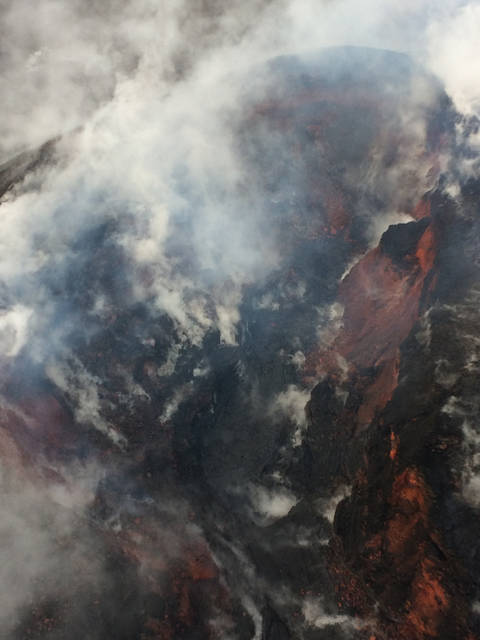Lava was no longer seen oozing into the ocean or sitting inside fissure 8 during an overflight Wednesday morning, according to the Hawaiian Volcano Observatory.
That appears to mark the first time that lava was not seen anywhere since the eruption on Kilauea’s lower East Rift Zone subsided almost four weeks ago.
It also could mean that the boat ramp at Pohoiki, which is blocked by a new black sand beach, will avoid being covered by lava. Molten rock had inundated parts of Isaac Hale Beach Park at the same location.
It remains unclear, however, whether the eruption is over or just taking a break, said Janet Babb, an HVO spokeswoman and geologist.
She also noted that there have been days during the past few weeks when no incandescence was visible within the fissure, so the absence of a lava pond Wednesday doesn’t mean that lava won’t be seen there again.
As for how long conditions have to remain calm before the eruption is considered over, Babb said that remains a matter of discussion. She noted the Mauna Ulu eruption took a break for three months before restarting.
“It’s probably more difficult to say when it’s over than to forecast when one might start,” Babb said.
As for the sand blocking the boat ramp, Dan Dennison, a spokesman for the state Department of Land and Natural Resources, said in an email that the department has not decided what to do about that.
“Until staff can get in and take a close look, we don’t have any idea about its future,” he said, referring to the state-owned ramp.
“Whatever may be decided will be done in close consultation with Hawaii County due to road access issues and the reopening of Issac Hale Beach Park.”
The lava flow field is crusted over but remains hot, and rain can produce steam and whiteout conditions, according to HVO.
Hurricane Lane also damaged some of HVO’s field sensors.
Babb said those are coming back online. She noted spikes in ground deformation data seen on HVO’s website are the result of the sensors becoming “settled” after being repaired.
Babb said the website will switch to data from a different tilt meter that wasn’t lost, and noted that changes in the deformation data on that meter might reflect impacts from heavy rainfall.
She said there’s been no actual deformation associated with magma at the summit or on the rift zone. Deformation, in which the ground moves up or down, could be a sign that eruption activity is going to resume.
The latest Kilauea eruption has destroyed more than 700 homes from Leilani Estates to Kapoho since starting May 3.
The Kilauea Disaster Recovery Center will be closed Labor Day weekend, according to the Federal Emergency Management Agency. It will reopen at 8 a.m. Tuesday at the Pahoa Neighborhood Facility, 15-3022 Kauhale St.
Evacuees can also register online at disasterassistance.gov and by calling 800-621-3362 or 800-462-7585.
More than $30 million in low-interest loans have been approved for people affected by the disaster through the U.S. Small Business Administration. That includes about $22.5 million for homeowners and $8 million for businesses.
That’s on top of individual assistance grants approved through FEMA, which totaled $7,188,518 as of Aug. 15.
The deadline to register with either agency is Sept. 12.
Email Tom Callis at tcallis@hawaiitribune-herald.com.




